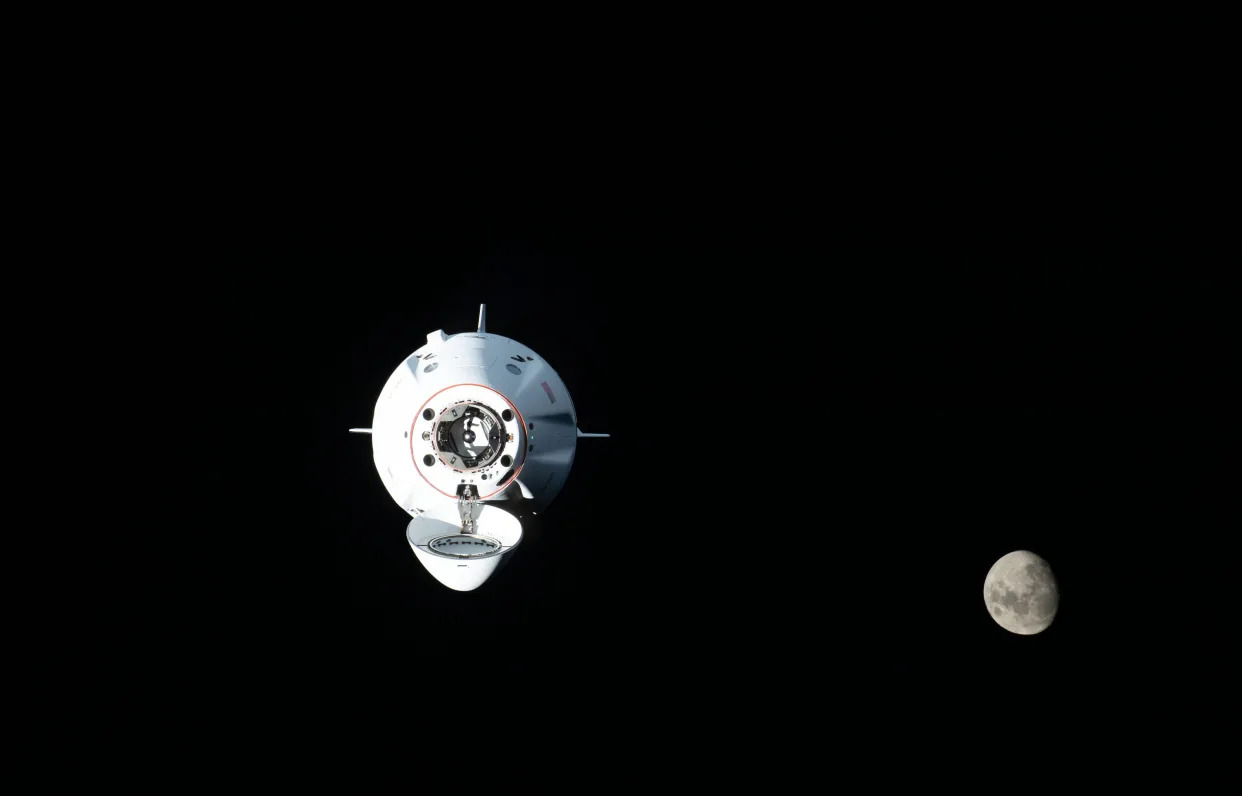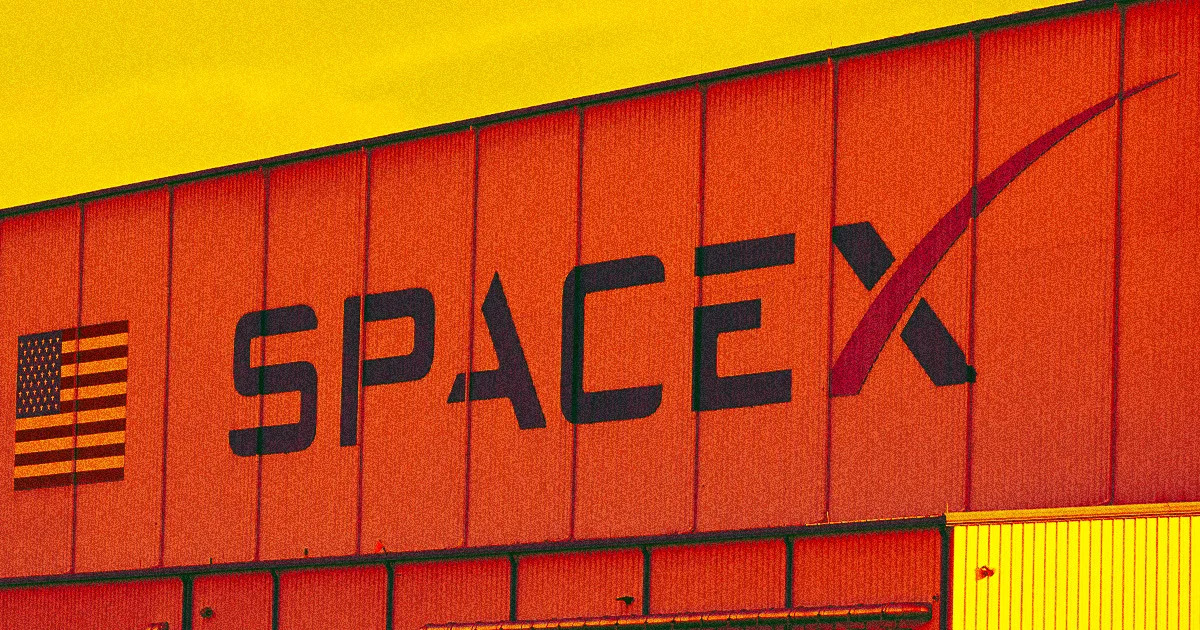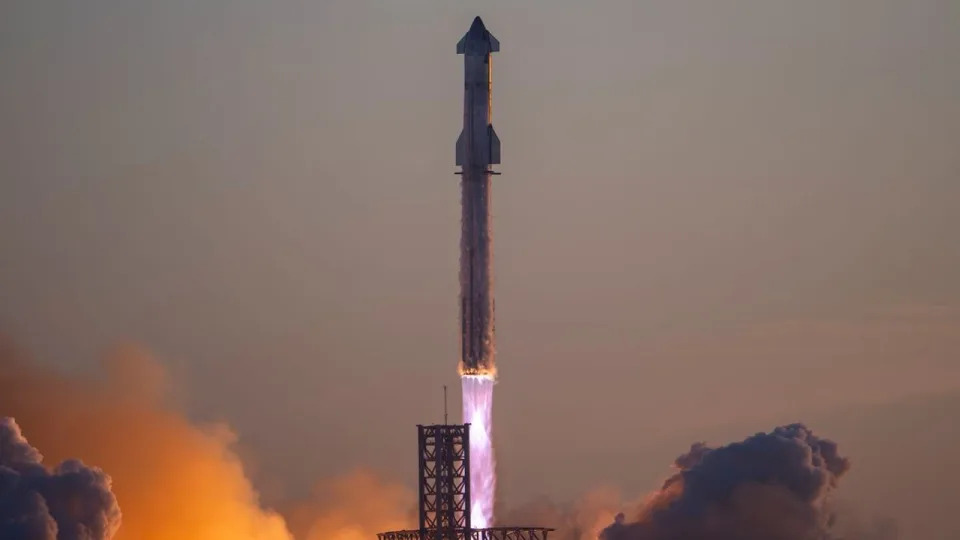Aria Alamalhodaei
Fri, February 2, 2024

SpaceX will become the co-owner of valuable data, biological samples, and possibly even patents and intellectual property related to human spaceflight, according to the terms and conditions of a new program inviting research on crewed Dragon missions.
The company started quietly inviting proposals "for exceptional science and research ideas that will enable life in space and on other planets," to be executed on orbit using its Dragon spacecraft capsule. Specifically, SpaceX says it's looking for research studies and experiments focused on fitness, or solutions to increase "efficiency and effectiveness," and those focused on human health during long-duration spaceflight missions.
Selected research study groups would have access to SpaceX’s crewed Dragon missions, opening up a whole new use case for one of the company’s core products.
The company has discussed using Dragon as an orbital lab, similar to the International Space Station (ISS), going back a decade. Evidently, the business case didn't make sense until recently. But by platforming on orbit research, the company would also gain access to valuable data in addition to any fees or other conditions presented to customers.
In the research collaboration terms and conditions, SpaceX states that it and the entity behind the scientific research will “jointly own” rights to all data recorded and samples obtained during the course of the research on orbit — regardless of whether this information was captured by SpaceX itself or the research institution. The document further specifies that all “technology” — which is expansively defined to include software, inventions, proprietary information and more — developed jointly by SpaceX and the research institution shall be jointly owned.
The agreement also states that the technology would be jointly owned “without accounting to the other parties,” legal language that means that each party could essentially commercialize or license the technology without any duty or obligation to the other party.
“Each party can license to anybody else, [though] they can't give an exclusive license to anyone else, because they don't have exclusive rights themselves,” Steven Wood, an attorney specializing in space law at Vela Wood, explained in a recent interview. “They can independently commercialize, and they have no duty or obligation to share any of the proceeds with the other party.”
There are clear exceptions: The document specifies that any technology developed solely using the researchers’ own equipment (defined here as equipment used “for the measurement, recording and transmission of data”) is owned solely by the researcher; however, even in this case, the data and samples would still clearly be jointly owned.
These are fairly standard terms for patents and inventions in this context, Wood explained, and shared that ownership of data and samples is also not out of bounds. But it reveals that commercializing Dragon would provide SpaceX with far more than just revenue.
“Expanding the light of consciousness”
SpaceX CEO Elon Musk has always been explicit about the company’s core goal: making human life multi-planetary, starting with Mars. The company has made considerable headway toward its mission, with the most visible example being the massive Starship rocket, which is being designed with deep space travel in mind. SpaceX has conducted two orbital flight tests of Starship and is poised to conduct a third sometime this month.
But getting to Mars is just one half of the problem. As NASA pointed out earlier this month — and SpaceX leadership no doubt understands — astronauts going to the Red Planet will face serious physical and psychological risks. As NASA most recently summarized in a white paper released last week, dangers of interplanetary travel can include exposure to high levels of radiation, the physiological effects of differing gravity environments, and long-term exposure to isolation and confining environments.
NASA has spent years studying the effects of microgravity on the human body. But the agency is clear that the risks are very different for astronauts who stay on the ISS for six months or even a year (which may not be so bad after all) versus those who may embark on a multi-year roundtrip to Mars.
Given SpaceX’s ambitions, it only makes sense that the company wants to platform even more research into solutions that could reduce these risks — and better set up their own mission to Mars for success.
Wife Sues SpaceX After Rocket Test Leaves Husband in Coma
Frank Landymore
Thu, February 1, 2024

Expendable Employees
SpaceX is being sued for negligence by the wife of an employee who was critically injured during a botched rocket engine test that left him in a coma, Reuters reports, as concerns over the workplace safety of the Elon Musk-led company continue to mount.
The employee, Francisco Cabada, was one of over 600 SpaceX injuries that were revealed in a Reuters investigation in November of last year.
Cabada was injured in January 2022, when a piece of a V2 Raptor engine, which powers SpaceX's Starship, broke off during pressure testing. It was sent flying into Cabada's head, fracturing his skull. Over two years later, the father of three is still in a coma.
The lawsuit was filed on his behalf by his wife, Ydy Cabada, in a state court in Los Angeles last week.
"It would have been nice to get a call from Elon Musk," Ydy told Reuters in November. "But I guess workers are just disposable to them."
Rush Job
According to anonymous SpaceX employees who spoke to Reuters, the part that struck Cabada, a fuel-controller assembly cover, had a known flaw that was not addressed before the test was carried out.
Just as damning, the investigation also revealed that senior managers at the Hawthorne California site where Cabada was injured were repeatedly warned about the dangers of rushing the engine's development.
The sheer tally of injuries suggests that there's a systemic problem at work — one that's already led to the death an employee of which SpaceX tried to keep under wraps. Many more have suffered broken or dislocated bones, crushed hands, lacerations, and even injuries that resulted in amputations, according to Reuters.
Breaking Point
Per the news agency's investigation, both current and former employees have blamed the unsafe environment on Musk's extremely demanding deadlines — a trademark of his leadership.
SpaceX, after all, is known to embrace the Silicon Valley ethos of "move fast and break things," which holds that with more failures comes quicker improvements.
Sometimes, though, things can "break" quite catastrophically, and you end up with an exploded Starship — or, far more tragically, injured employees.
It's worth noting that this isn't the only Musk-led venture with workplace safety concerns. For years, the EV automaker Tesla has come under fire for gruesome injuries that have occurred at its factories, amidst consistently re-emerging reports that workers are forced to sleep at the assembly line.
What will come of the lawsuit is unclear, but it seems that as long as a quick turnaround is the bottom line at these companies, workers will continue to pay the price.
More on SpaceX: SpaceX Buys Mysterious Aircraft
US military eyes SpaceX Starship for 'sensitive and potentially dangerous missions': report
Brett Tingley
Wed, January 31, 2024

A large silver rocket on a launch pad fires its engines, creating a massive plume of fire and smoke.
The U.S. Department of Defense (DOD) has reached out to SpaceX to inquire about using Starship on its own, flying the massive rocket as a "government-owned, government-operated" asset on "sensitive and potentially dangerous missions," according to a recent report in Aviation Week.
Currently, the DOD contracts SpaceX as a launch services provider; in this new proposed arrangement the Pentagon would actually take control of the vehicle on its own.
Related: Space is now 'most essential' domain for US military, Pentagon says
Aviation Week cites comments made on Tuesday (Jan. 30) by Gary Henry, a Senior Advisor for National Security Space Solutions at SpaceX, during the 2024 Space Mobility Conference held in Orlando, Florida.
"We have had conversations … and it really came down to specific missions, where it's a very specific and sometimes elevated risk or maybe a dangerous use case for the DOD where they’re asking themselves: 'Do we need to own it as a particular asset … SpaceX, can you accommodate that?'" Henry said at the conference.
"We've been exploring all kinds of options to kind of deal with those questions," Henry added.

a massive rocket lifts off above a plume of fire
The DOD has been considering using Starship for years. As early as 2020, U.S. Transportation Command (USTRANSCOM) was discussing using the giant reusable rocket — which is not yet operational — for transporting cargo or even personnel rapidly around the world.
"Think about moving the equivalent of a C-17 payload anywhere on the globe in less than an hour. Think about that speed associated with the movement of transportation of cargo and people," former commander of USTRANSCOM Gen. Stephen Lyons said in Oct. 2020. "There is a lot of potential here, and I'm really excited about the team that's working with SpaceX on an opportunity, even perhaps, as early as '21, to be conducting a proof of principle."
Col. Eric Felt, director of space architecture for the Office of the Secretary of the Air Force for Space Acquisition and Integration, added that "there might be some use cases where there needs to be a government-owned, government-operated [vehicle], and that transfer can happen on the fly," Aviation Week reports.
RELATED STORIES:
— SpaceX targeting February for Starship's 3rd flight test
— Pentagon moves to declassify some secret space programs and technologies
— What is the U.S. Space Force and what does it do?
SpaceX founder and CEO Elon Musk has even hinted at using Starship to send 1,000 human passengers on point-to-point flights around the world at hypersonic speeds held in place by amusement-park-like restraints. "Would feel similar to Space Mountain in a lot of ways, but you'd exit on another continent," Musk wrote on X in 2019.
Aside from potential U.S. military applications and its traditional usage as a commercial launch vehicle, Starship is being tapped for NASA's Artemis program. The agency plans to use Starship as a moon lander to ferry human crews to and from the lunar surface, beginning with the Artemis 3 mission no earlier than 2026.
A lot of development and testing has to go right before that can happen, though. SpaceX will first have to conduct a successful demonstration in which Starship will be used as an orbital refueling platform to top off a human lander after it uses most of its fuel after it leaves Earth and heads to the moon.
Starship is SpaceX's next-generation launch vehicle that the company hopes will help humanity build settlements on the moon and Mars. The massive rocket has flown on two test flights to date; one in April 2023 and again in November 2023. A third test flight could come as soon as February 2024, pending regulatory approval from the U.S. government.

No comments:
Post a Comment